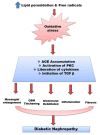Insights into the Uses of Traditional Plants for Diabetes Nephropathy: A Review
- PMID: 35877423
- PMCID: PMC9316237
- DOI: 10.3390/cimb44070199
Insights into the Uses of Traditional Plants for Diabetes Nephropathy: A Review
Abstract
Diabetic nephropathy (DN) is a serious kidney illness characterized by proteinuria, glomerular enlargement, reduced glomerular filtration, and renal fibrosis. DN is the most common cause of end-stage kidney disease, accounting for nearly one-third of all cases of diabetes worldwide. Hyperglycemia is a major factor in the onset and progression of diabetic nephropathy. Many contemporary medicines are derived from plants since they have therapeutic properties and are relatively free of adverse effects. Glycosides, alkaloids, terpenoids, and flavonoids are among the few chemical compounds found in plants that are utilized to treat diabetic nephropathy. The purpose of this review was to consolidate information on the clinical and pharmacological evidence supporting the use of a variety of medicinal plants to treat diabetic nephropathy.
Keywords: antioxidant; diabetic nephropathy; medicinal plants; streptozotocin.
Conflict of interest statement
The authors declare that they have no conflicts of interest.
Figures
Similar articles
-
The Therapeutic Effect of Active Vitamin D Supplementation in Preventing the Progression of Diabetic Nephropathy in a Diabetic Mouse Model.J Diabetes Res. 2020 Nov 26;2020:7907605. doi: 10.1155/2020/7907605. eCollection 2020. J Diabetes Res. 2020. PMID: 33294462 Free PMC article.
-
Moringa oleifera Lam. seed extract protects kidney function in rats with diabetic nephropathy by increasing GSK-3β activity and activating the Nrf2/HO-1 pathway.Phytomedicine. 2022 Jan;95:153856. doi: 10.1016/j.phymed.2021.153856. Epub 2021 Nov 16. Phytomedicine. 2022. PMID: 34856477
-
Recent advances in understanding the biochemical and molecular mechanism of diabetic nephropathy.Biochem Biophys Res Commun. 2013 Apr 19;433(4):359-61. doi: 10.1016/j.bbrc.2013.02.120. Epub 2013 Mar 26. Biochem Biophys Res Commun. 2013. PMID: 23541575 Review.
-
Lessons learned from studies of the natural history of diabetic nephropathy in young type 1 diabetic patients.Pediatr Endocrinol Rev. 2008 Aug;5 Suppl 4:958-63. Pediatr Endocrinol Rev. 2008. PMID: 18806710 Review.
-
Bioactive phytochemicals that regulate the cellular processes involved in diabetic nephropathy.Phytomedicine. 2018 Jan 15;39:146-159. doi: 10.1016/j.phymed.2017.12.018. Epub 2017 Dec 18. Phytomedicine. 2018. PMID: 29433676 Review.
Cited by
-
Chemical Composition of the Cinnamomum malabatrum Leaf Essential Oil and Analysis of Its Antioxidant, Enzyme Inhibitory and Antibacterial Activities.Antibiotics (Basel). 2023 May 22;12(5):940. doi: 10.3390/antibiotics12050940. Antibiotics (Basel). 2023. PMID: 37237843 Free PMC article.
-
Exploration of Artemisinin Against IgA Nephropathy via AKT/Nrf2 Pathway by Bioinformatics and Experimental Validation.Drug Des Devel Ther. 2023 Jun 7;17:1679-1697. doi: 10.2147/DDDT.S403422. eCollection 2023. Drug Des Devel Ther. 2023. PMID: 37309415 Free PMC article.
-
Roles of microRNA-192 in diabetic nephropathy: the clinical applications and mechanisms of action.Front Endocrinol (Lausanne). 2023 Jun 15;14:1179161. doi: 10.3389/fendo.2023.1179161. eCollection 2023. Front Endocrinol (Lausanne). 2023. PMID: 37396169 Free PMC article. Review.
-
Study of MicroRNA-192 as an Early Biomarker for Diagnosis of Diabetic Nephropathy.Diagnostics (Basel). 2025 Jun 13;15(12):1504. doi: 10.3390/diagnostics15121504. Diagnostics (Basel). 2025. PMID: 40564825 Free PMC article.
-
In Situ Aqueous Spice Extract-Based Antifungal Lock Strategy for Salvage of Foley's Catheter Biofouled with Candida albicans Biofilm Gel.Gels. 2025 Jan 1;11(1):23. doi: 10.3390/gels11010023. Gels. 2025. PMID: 39851994 Free PMC article.
References
-
- Sun H., Saeedi P., Karuranga S., Pinkepank M., Ogurtsova K., Duncan B.B., Stein C., Basit A., Chan J.C., Mbanya J.C., et al. IDF Diabetes Atlas: Global, regional and country-level diabetes prevalence estimates for 2021 and projections for 2045. Diabetes Res. Clin. Pract. 2022;183:109–119. doi: 10.1016/j.diabres.2021.109119. - DOI - PMC - PubMed
-
- Zhang S., Ge Q., Chen L., Chen K. Studies of the Anti-Diabetic Mechanism of Puerarialobata Based on Metabolomics and Network Pharmacology. Processes. 2021;9:1245. doi: 10.3390/pr9071245. - DOI
-
- Vinod P.B. Pathophysiology of diabetic nephropathy. Clin. Queries Nephrol. 2012;1:121–126. doi: 10.1016/S2211-9477(12)70005-5. - DOI
Publication types
LinkOut - more resources
Full Text Sources


